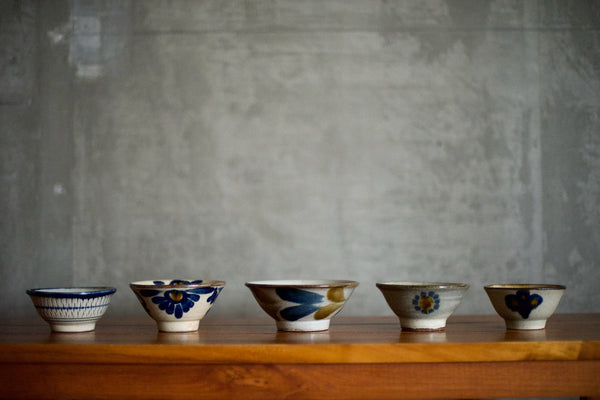
Tsuboya Pottery(Yachimun): Unveiling Okinawa's Cultural Ware
What is Tsuboya Pottery?
Tsuboya is made in Naha City, Okinawa Prefecture, an island in southern Japan, also known as Yachimun. The heavy, sturdy, weighty vessels have a warmth reminiscent of the Okinawan climate, and have been handed down in the hearts of those who see and use them. The rich nature of Okinawa is depicted on the surface of the pottery, evoking a sense of calm and nostalgia. If you go to Naha City, you will find a tourist attraction called "Tsuboya Yachimun Street," where many stores sell Tsuboya pottery. You can enjoy a wide variety of Tsuboya pottery, so it is recommended that you visit one when you visit Naha.
History of Tsuboya Pottery
Tsuboya pottery has a long history, dating back to the time of the Kingdom of the Ryukyu, which ruled the area before Okinawa Prefecture was established. It is said that the technique of Arayachi(Ara-yaki), from which Tsuboya is derived, was introduced during this period. The technique was introduced during this period, and Tsuboya pottery boasts a history of about 600 years, but at that time, imports were the mainstream and domestic production was not that active.
In 1609, the Shimazu Clan invaded Ryukyu, and the Ryukyu Kingdom came under the Shimazu Clan's occupation. Trade with foreign countries, which had been active up to that time, began to decline, and the amount of pottery imported also decreased. The king of Ryukyu at that time, King Shotei, decided to start making pottery for the purpose of industrial promotion, as it was necessary to produce daily necessities on his own. He invited potters from the Korean peninsula and began to produce high quality pottery domestically, making full use of their skills. The pottery produced using the techniques introduced at this time was called joyachi(jo-yaki), which also became the basis of Tsuboya pottery. The dynasty continued to support the production of ceramics and porcelain, and Tsuboya pottery continued to grow and develop.
However, in the Meiji period (1868-1912), Okinawa Prefecture replaced the Ryukyu Kingdom as the governing body of the region. Although Tsuboya pottery had been protected by the Ryukyu Kingdom, the large influx of inexpensive, lightweight pottery from Main island, Japan, caused a marked decline in demand for Tsuboya pottery. In such a situation, a turning point came in the Taisho period (1912-1926). Shoji Hamada and Muneyoshi Yanagi, who founded the "Mingei Movement," a movement to find beauty in everyday vessels, spread the excellence of Tsuboya pottery throughout Japan. As a result, Tsuboya gradually became popular in Japan.
Fortunately, the Tsuboya area suffered relatively minor damage, and the Tsuboya pottery industry was quickly rebuilt and gradually regained its momentum. Today, the Tsuboya Yachimun Street is one of the most popular tourist attractions in Naha City, and is loved by many people.
Characteristics of Tsuboya Pottery
Tsuboya pottery is made in the island nation of Okinawa, and the type of clay used is slightly different from that used in the main island of Japan. Tsuboya is made of red clay, which turns black when fired. However, black tableware is not very appetizing, so the potter dipped it in a solution of dissolved white clay and painted patterns on it. Tsuboya pottery made in this way is simple, heavy, and powerful, giving it a sense of warmth and connection with nature as a vessel.
Technically speaking, Tsuboya can be classified into two types: joyachi(jo-yaki) and arayachi(ara-yaki). Joyachi is pottery that is glazed, and arayachi is pottery that is unglazed. Joyachi is used to make tableware, sake cups, and flower vases, while arayachi is mainly used to make jars and pots.
Okinawa guardian deity Shisa

Shisa is famous in Okinawa, where Tsuboya pottery is made. Shisa means "lion (in Japanese Shi-Shi)" in the Okinawan dialect and is said to be based on the Egyptian sphinx. Shisa are usually placed in sets of two, and are used in Okinawan homes as guardian deities to ward off evil spirits and prevent misfortune from entering the home. There are also many families that place only one Shisa on the roof of their house.
By the way, did you know that there is a specific way to place a pair of Shisa on the roof?
In fact, when you look at them from the front, the one on the left has its mouth closed, and the one on the right has its mouth open! If you have a chance to visit Okinawa, please check it out. Also, each of these left and right Shisa has its own gender and meaning. The one on the left with its mouth closed is a female Shisa, which means "to keep happiness from escaping”,The open-mouthed male Shisa on the right is said to "bring in good fortune and ward off evil spirits”. Shisa, the guardian god of Okinawan people, has such meanings. Since there is Tsuboya pottery of Shisa in Okinawa, it might be a good idea to buy one as a guardian deity when you travel to Okinawa.
